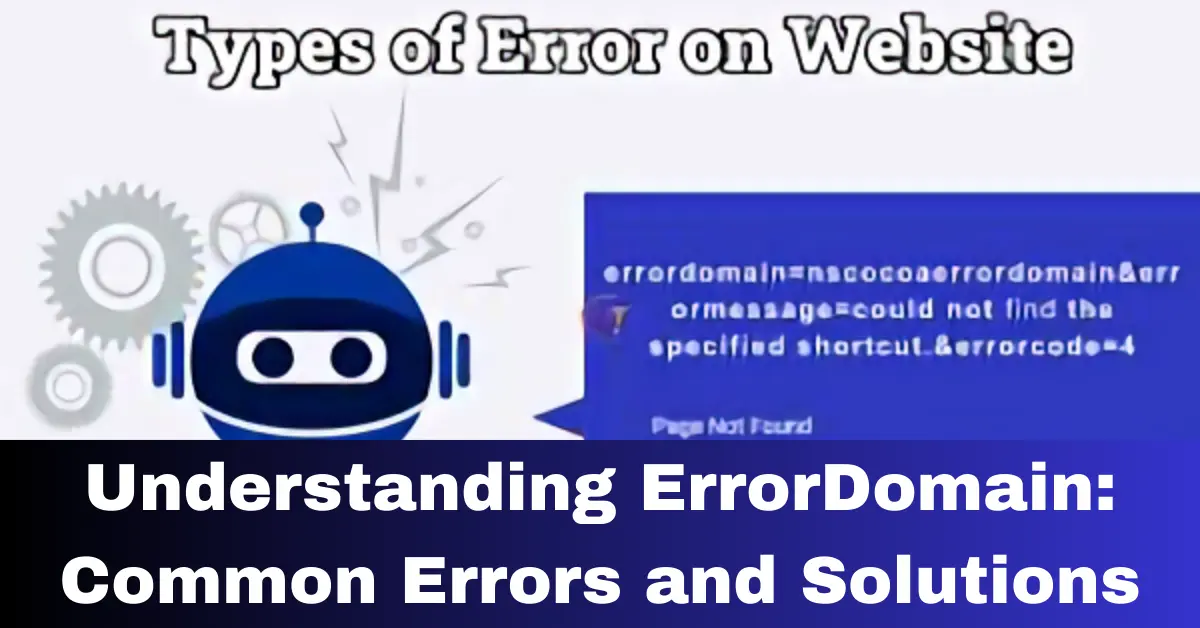Introduction
In the world of software development, encountering errors is a common challenge that developers face. One such important aspect of handling errors is understanding ErrorDomain. Imagine ErrorDomain as a categorized library where software errors are neatly organized. Each category, or domain, helps developers identify and troubleshoot specific types of errors more efficiently.
Understanding ErrorDomain isn’t just about technical jargon; it’s about enhancing user experience and streamlining the troubleshooting process. By grasping the common errors that fall under ErrorDomain and learning effective solutions, developers can ensure smoother-running software and happier users.
In this article, we’ll delve into what ErrorDomain is all about, explore some of the typical errors you might encounter, and provide practical solutions to fix them. Let’s unravel the mysteries of ErrorDomain and equip you with the knowledge to tackle software errors effectively!
What is “Understanding ErrorDomain: Common Errors and Solutions”?
“Understanding errordomain=nscocoaerrordomain&errormessage=could not find the specified shortcut.&errorcode=4: Common Errors and Solutions” is a comprehensive guide aimed at demystifying ErrorDomain in software development. ErrorDomain acts as a framework within which various errors are categorized and managed. This guide explores the significance of ErrorDomain, delves into typical errors that developers encounter within this domain, and provides practical solutions to resolve them effectively.
By grasping the nuances of ErrorDomain and familiarizing yourself with its common errors and solutions, you can enhance your troubleshooting skills, improve software stability, and ultimately deliver a better user experience.
Why Understanding ErrorDomain and Its Common Errors Is Important
Enhanced Troubleshooting Efficiency
Clear Identification: ErrorDomain categorizes errors, making it easier to identify and isolate specific issues within software systems.
Faster Resolution: Knowing common errors helps developers troubleshoot and fix issues more quickly, reducing downtime and improving software reliability.
Improved User Experience
Smooth Operation: Resolving errors promptly ensures that software functions smoothly without interruptions or unexpected behaviors.
Positive User Perception: Minimizing errors leads to increased user satisfaction, as they experience a more reliable and stable application.
Streamlined Development Process
Efficient Development: Developers equipped with knowledge of ErrorDomain can anticipate potential issues and build more robust code from the outset.
Iterative Improvement: Understanding common errors allows for iterative improvements, enhancing the quality of future software releases.
Effective Error Handling
Proactive Approach: Knowledge of ErrorDomain empowers developers to implement proactive error-handling strategies, minimizing the impact of errors on end-users.
Comprehensive Testing: It facilitates thorough testing scenarios to validate error-handling mechanisms, ensuring comprehensive software quality assurance.
Industry Best Practices
Adherence to Standards: Familiarity with ErrorDomain aligns developers with industry best practices in error management and software development.
Continuous Learning: Staying updated on common errors and solutions fosters continuous learning and professional growth within the software development community.
Common FAQs About ErrorDomain
What is ErrorDomain?
ErrorDomain is a concept in software development where errors are categorized into specific domains or groups. Each domain helps developers identify and handle different types of errors more efficiently.
Why is it important to understand ErrorDomain?
Understanding ErrorDomain allows developers to categorize and manage errors systematically. This knowledge enhances troubleshooting efficiency, improves software reliability, and ultimately enhances the user experience by reducing downtime and unexpected errors.
What are common errors found in ErrorDomain?
Some common errors found in ErrorDomain include:
Network Errors: Issues related to network connectivity or data transmission.
File System Errors: Problems with file handling or storage operations.
Authentication and Authorization Errors: Access-related issues for users or systems.
Input Validation Errors: Errors due to invalid user input or data format issues.
How can understanding ErrorDomain benefit developers?
Efficient Troubleshooting: Developers can quickly pinpoint and resolve specific errors, minimizing downtime.
Better User Experience: Reduced errors lead to smoother application performance and increased user satisfaction.
Improved Development Practices: Knowing common errors helps in building more robust and reliable software from the start.
How can developers handle errors within ErrorDomain effectively?
Developers can handle errors within ErrorDomain effectively by:
Implementing Robust Error Handling: Using try-catch blocks and error handling mechanisms to gracefully manage errors.
Logging and Monitoring: Implementing logging tools to track errors in real-time and monitoring systems for proactive error detection.
Testing and Validation: Conducting thorough testing to identify and address potential errors before software deployment.
Conclusion
Understanding ErrorDomain is like having a roadmap for handling software errors effectively. By categorizing and addressing common errors, developers can troubleshoot issues faster, improve software reliability, and deliver a smoother user experience.
Whether you’re a seasoned developer or just starting out, mastering ErrorDomain ensures you’re equipped to build better software and navigate challenges with confidence. Stay curious, keep learning, and embrace the power of ErrorDomain to enhance your coding journey!











